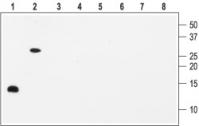BDNF Rabbit Polyclonal Antibody
Other products for "BDNF"
Specifications
| Product Data | |
| Applications | IHC, WB |
| Recommended Dilution | WB: 1:200-1:2000; IHC: 1:100-1:3000 |
| Reactivities | Human, Mouse, Rat |
| Host | Rabbit |
| Clonality | Polyclonal |
| Immunogen | Peptide (C)VLEKVPVSKQLK, corresponding to amino acid residues 166-178 of human BDNF (precursor). |
| Formulation | Lyophilized. Concentration before lyophilization ~0.8mg/ml (lot dependent, please refer to CoA along with shipment for actual concentration). Buffer before lyophilization: Phosphate buffered saline (PBS) pH 7.4, 1% BSA, 0.025% NaN3. |
| Purification | Affinity purified on immobilized antigen. |
| Conjugation | Unconjugated |
| Storage | Store at -20°C as received. |
| Stability | Stable for 12 months from date of receipt. |
| Gene Name | brain-derived neurotrophic factor |
| Database Link | |
| Background | Brain derived neurotrophic factor (BDNF) is a member of the neurotrophin family of growth factors which includes nerve growth factor (NGF), neurotrophin-3 (NT-3) and neurotrophin-4/5 (NT-4/5). All neurotrophins are synthesized as preproneurotrophin precursors that are subsequently processed within the intracellular transport pathway to yield proneurotrophins that are further processed to generate the mature form. The mature form of BDNF is a non-covalent stable homodimer that can be secreted in both constitutive and regulated pathways. BDNF conveys its activity by binding to two classes of receptors, a member of the Trk receptor tyrosine kinase family (TrkB) and the pan-neurotrophin receptor p75NTR. Binding of BDNF to the TrkB receptor triggers ligand-induced dimerization and autophosphorylation of tyrosine residues. This activates various signaling cascades such the MAPK, PI3K and PLC? pathways that are involved in cell growth, survival and differentiation of neurons in the central and peripheral nervous system. Interestingly, recent evidence suggests that BDNF may influence target cell function via ion channel modulation. Ion channel activity in the target cells can be modulated by a TrkB-mediated mechanism that has not yet been determined. BDNF is able to block both Kv1.3 and AMPA-subtype glutamate ion channel currents in sensory neurons, while it can induce activation of the TRPC3 cation channel in neurons and of the Nav1.9 Na+ channel in hippocampal neurons. These newly recognized BDNF actions underlie its â??rapidâ? neuronal functions that include changes in neuronal excitability, plasticity and synaptic transmission. Due to the high degree of homology between the different neurotrophins it has been difficult to produce truly specific antibodies against any of them. We have now produced a highly specific antibody against BDNF which recognizes exclusively BDNF. |
| Synonyms | ANON2; BULN2 |
| Reference Data | |
| Protein Families | Adult stem cells, Druggable Genome, Embryonic stem cells, ES Cell Differentiation/IPS, Induced pluripotent stem cells, Secreted Protein, Transmembrane |
| Protein Pathways | Huntington's disease, MAPK signaling pathway, Neurotrophin signaling pathway |
Documents
| Product Manuals |
| FAQs |
{0} Product Review(s)
0 Product Review(s)
Submit review
Be the first one to submit a review
Product Citations
*Delivery time may vary from web posted schedule. Occasional delays may occur due to unforeseen
complexities in the preparation of your product. International customers may expect an additional 1-2 weeks
in shipping.






























































































































































































































































 Germany
Germany
 Japan
Japan
 United Kingdom
United Kingdom
 China
China




